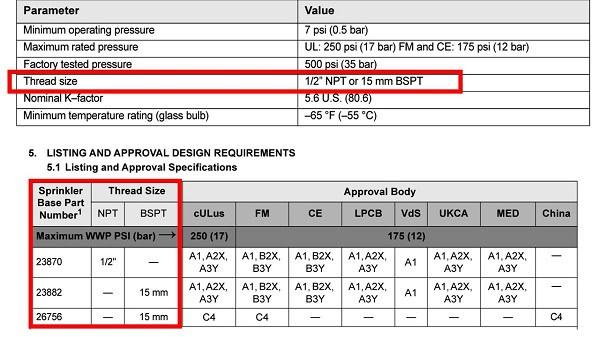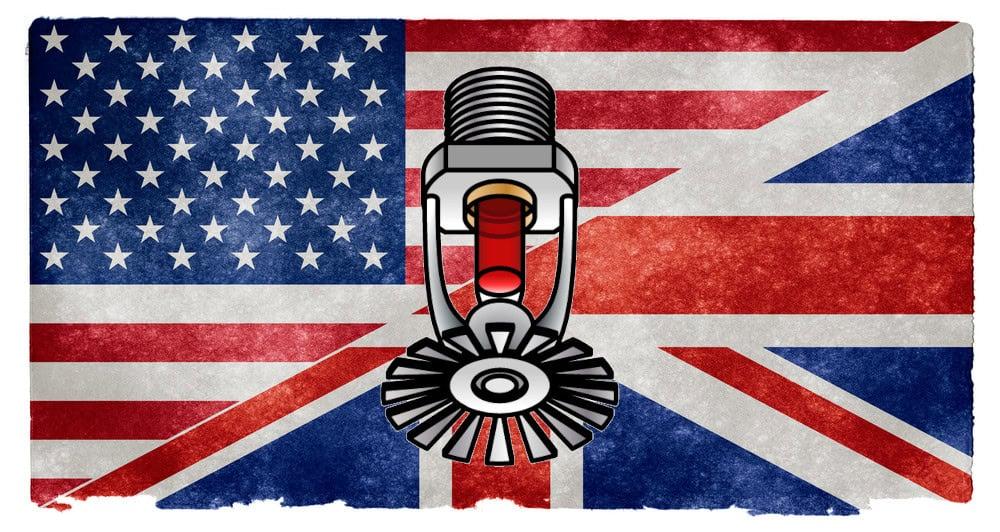Understanding worldwide pipe thread standards for fire sprinkler connections
Fire sprinklers have tapered threads following two major worldwide standards: National Pipe Taper (NPT) and British Standard Pipe Taper (BSPT). The fire sprinklers manufactured with these standards are not interchangeable, so what’s the difference between BSPT vs NPT?
Read on to find out, including where BSPT and NPT threads are used, their physical characteristics, where “ISO” and other threads enter the mix, and how to ensure you get the right part.
- BSPT vs NPT: the basics
- BSPT vs NPT: physical differences
- Getting the right fire sprinkler head sizes on data sheets
QRFS is based in the USA and stocks and sells NPT sprinklers and fittings. Shop our catalog today!
BSPT vs NPT: the basics
Tapered, threaded connections are the norm for fire sprinklers. Installers screw the male thread into a female fitting to form a pressure-tight seal, often after applying pipe dope or PTFE tape. Tapered-thread joints are also widely used in plumbing and industrial applications.
However, depending on where you are in the world, standard connections have different threads and measurements. A system uses NPT or a BSPT/ISO-equivalent connection, and these standards ensure a specific size will always fit, regardless of the manufacturer. Fortunately, it’s uncommon for countries and industries to mix the two types of threads.
National Pipe Taper: Sizes and where it’s used
In the United States, the standard for tapered threads is NPT. The American National Standards Institute (ANSI) and the American Society of Mechanical Engineers (ASME) lay out National Pipe Taper’s dimensions in the ASME B1.20.1 standard.
In addition to the US, NPT is also commonly used in Canada, many parts of Mexico and South America, as well as the Middle East and the Philippines. According to a Viking technical rep, NPT even sees use within Europe.
NPT is a US “customary unit,” so it’s measured in inches. However, NPT measurements are “nominal sizes” (also called “trade sizes”), meaning, for example, 1/2″ NPT threads don’t measure exactly 1/2”. Instead, the “major diameter” of a 1/2″ NPT male fitting is 0.84”.
Check out these basic NPT specs:

British Standard Pipe Taper: Sizes and where it’s used
BSPT is naturally used in the United Kingdom and many Commonwealth countries (e.g., Australia and New Zealand). However, it’s also common in any country that relies on the International Organization for Standardization’s (ISO) ISO 7: Pipe threads where pressure-tight joints are made on the threads to define thread dimensions. This encompasses much of Europe, plus many Asian countries such as China, Japan, and India.
Given the ISO angle, not every country calls these threads “BSPT,” and they might refer to the pipe size in ISO units. For example, the US-based manufacturer Reliable Sprinkler labels non-NPT heads “7-R1/2” to indicate the same thing as “15mm BSPT.” Similarly, Japan has “JIS,” Germany has “DIN 2999,” and India has IS 554—but they’re basically the same thing as ISO and BSPT.
Like NPT, BSPT is nominal, so its “on-paper” sizes aren’t its real ones. The nominal measurement might also use inches. For example, Reliable’s “7-R1/2” size references 1/2″ threads.
Nevertheless, as an international ISO standard, BSPT and its related versions more commonly appear in millimeters, given the metric system is preferred by most of the world. Except for those published by Reliable, sprinkler data sheets from major manufacturers always list the BSPT size in millimeters.
You can see some basic BSPT specs in the table below:

BSPT vs NPT: the physical differences
You probably won’t spot the difference between a BSPT and NPT fitting with the naked eye—it’s subtle. However, four key differences make the two standards physically incompatible.
1. The thread angle
During cutting, peaks and valleys are formed in the metal. The walls of the valleys of NPT threads form 60-degree angles, whereas BSPT threads have 55-degree angles.
2. The shape of the peaks and valleys in the threads
The cutting die used to cut NPT threads makes sharp peaks and valleys, while a BSPT die cuts rounded peaks and valleys.

3. The sizes of the threads
Actual thread sizes differ slightly between NPT and BSPT connections, even when their nominal sizes match. For example, while the major diameter of a 1/2″ NPT thread is 0.84”, the major diameter of a 1/2″/15mm BSPT thread is 0.825.”
4. Different thread counts per inch
Last, and perhaps most importantly, NPT and BSPT have slightly different numbers of threads per inch. The difference is small, making it easy to cross-thread mismatched male and female fittings, which can ruin parts made of soft metals like brass (including fire sprinklers).
There are two exceptions to this last rule: 1/2″ and 3/4″ nominal NPT and BSPT threads share the same number of threads per inch: 14. These also happen to be the two most common fire sprinkler sizes.
But just because an NPT and BSPT connection has the same thread count doesn’t mean you can safely mix these fittings. The other differences in thread angle, shape, and size still mean a connection won’t work and create a water-tight seal.
BSPT vs NPT: Getting the right fire sprinkler head size on data sheets
Given the critical differences between BSPT and NPT, you want to be certain you’re getting the correct part. Fortunately, every major fire sprinkler company, including Viking, Victaulic, Tyco, Reliable, and Senju, offers sprinklers in both ‘flavors.’
Most sprinkler data sheets include ordering information for each connection type, usually on the first page and in the “approvals” tables. Tyco is an exception; the company publishes separate data sheets by thread type that are available in the specific regions that use it.
The BSPT and NPT versions of a sprinkler share the same sprinkler identification number (SIN). SINs correspond with a head’s unique features and performance characteristics, including K-factor, deflector type/orientation, and response type. Threads don’t affect how a sprinkler behaves in a fire, so different thread styles don’t get different SINs.
However, they do have different part numbers, so check the data sheet to verify it.

Different-thread versions of a sprinkler can also have unique listings and approvals. You’ll find this information in a listings and approvals table, usually toward the middle or end of a data sheet.
Two thread standards, one mission
NPT and BSPT/ISO threads may be incompatible, but they serve the same ultimate purpose. The standards ensure it’s easy to mass-produce interchangeable pipes and fittings that form reliable, pressure-tight seals for systems that use these connections.
Most people don’t need to worry much about the differences between BPST and NPT. If you live in an ‘NPT country’ or ‘BSPT/ISO country,’ sellers often won’t stock items with the other thread. But there are exceptions and part-number differences, so knowing the thread options can be important.
Shop QRFS’s NPT sprinkler catalog today. You can also use our QuickFinder to ID sprinklers and accessories by SIN fast!
If you have trouble finding a part or have other questions, contact us at 888.361.6662 or support@qrfs.com.
This blog was originally posted at blog.qrfs.com. If this article helped you, check us out at Facebook.com/QuickResponseFireSupply or on Twitter @QuickResponseFS.



1. The thread angle
During cutting, peaks and valleys are formed in the metal. The walls of the valleys of NPT threads form 55-degree angles, whereas BSPT threads have 60-degree angles.
Correction to be made on the NPT angle. It should be 60 degrees not 55 degrees. and BSPT will have 55 degrees.
Raja — Oof; we transposed those numbers—now corrected. Thank you!